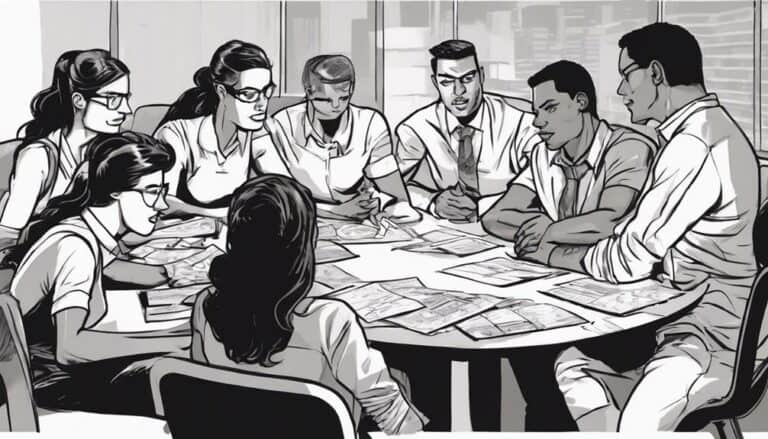Have you ever considered the immense power that nonverbal communication holds within a team dynamic?
The subtle gestures, expressions, and body language can either make or break the cohesion of a group.
Understanding how nonverbal cues influence teamwork and learning strategies to enhance these signals is vital for effective collaboration.
By delving deeper into the impact of nonverbal communication on team dynamics, you'll uncover valuable insights that could potentially transform the way your team operates and interacts.
Key Takeaways
- Nonverbal communication shapes rapport, trust, and collaboration in teams.
- Misunderstandings arise from varying nonverbal signals.
- Improving self-awareness and skills enhances nonverbal communication.
- Effective nonverbal cues boost team performance and leadership impact.
Importance of Nonverbal Communication
Nonverbal communication serves as a foundational element in team dynamics, shaping the core aspects of rapport, trust, and connection among team members. Within a team, nonverbal cues such as eye contact, facial expressions, important body language, and gestures play a critical role in conveying emotions, attitudes, and intentions. Effective utilization of these nonverbal communication cues enhances team collaboration and overall performance by providing valuable feedback beyond words.
Maintaining good eye contact during discussions demonstrates attentiveness and shows respect for the speaker, fostering a sense of engagement within the team. Positive facial expressions like smiles or nods can convey encouragement, support, and agreement, strengthening the bonds among team members. Additionally, using open and inviting body language and gestures can create a welcoming environment that promotes active participation and idea-sharing within the team.
Challenges in Team Dynamics
Exploring the intricacies of team dynamics presents a myriad of challenges that can greatly impact overall collaboration and performance. When considering nonverbal communication within teams, several issues can arise:
- Essential nonverbal cues: Varying signals among team members can lead to misunderstandings and conflicts, hindering effective collaboration.
- Critical differences: Variances in nonverbal communication norms can create barriers, causing misunderstandings and affecting trust within the team.
- Vital messages: Unclear or contradictory nonverbal signals can disrupt team interactions, leading to confusion and a lack of trust among members.
- External influences: Stress and other external factors can impact nonverbal cues, affecting team dynamics and collaboration.
To navigate these challenges, it's important for team members to practice awareness of their own nonverbal cues and actively work on improving their communication skills. By fostering a culture of understanding and open communication, teams can enhance trust, reduce conflicts, and improve overall collaboration.
Strategies for Improving Nonverbal Signals
To enhance team dynamics and foster effective communication, consider incorporating specific strategies to improve your nonverbal signals. Developing self-awareness of your nonverbal cues is vital for improved interactions within a team. By utilizing appropriate facial expressions and gestures, you can enhance team communication and understanding. Actively observing and interpreting your team members' nonverbal cues can strengthen collaboration and create a more cohesive team environment. Integrating nonverbal cues with verbal messages reinforces key points and fosters better teamwork. Regularly practicing and honing your nonverbal communication skills is essential for positively impacting team dynamics. Below is a table outlining strategies to enhance your nonverbal communication skills effectively:
| Strategies for Improving Nonverbal Signals |
|---|
| 1. Increase self-awareness of nonverbal cues |
| 2. Utilize appropriate facial expressions and gestures |
| 3. Actively observe and interpret team members' nonverbal cues |
Enhancing Team Collaboration
Enhance team collaboration by harnessing the power of nonverbal cues to express emotions, attitudes, and feelings effectively, fostering a more connected and productive team environment. Nonverbal communication plays an important role in team dynamics by reinforcing and complementing verbal messages, ensuring clear communication within the team.
Regulating conversation flow, nonverbal cues establish rapport and connection among team members, enhancing overall team interactions. Additionally, nonverbal signals help emphasize important points or show agreement during discussions, further strengthening team collaboration.
Improving nonverbal communication skills can greatly boost team performance and productivity, making it essential to pay attention to these cues to create a more cohesive and efficient team environment. By being aware of and utilizing nonverbal cues effectively, you can enhance team collaboration and communication, ultimately leading to improved team outcomes.
Impact of Nonverbal Communication on Leadership
Nonverbal communication in leadership greatly influences team dynamics by conveying confidence, authority, and emotional intelligence, shaping the overall team atmosphere and interactions. Effective nonverbal cues from leaders can inspire trust, boost morale, and foster a positive team environment.
Your body language, gestures, and facial expressions play a significant role in how your team perceives you. Aligning verbal and nonverbal messages can enhance team motivation and engagement. Improving your nonverbal communication skills involves being mindful of how you present yourself physically.
Conclusion
Just as a conductor uses subtle gestures to guide an orchestra, your nonverbal communication directs the symphony of your team dynamics.
By tuning into your own cues and harmonizing with your teammates' signals, you can create a beautiful melody of collaboration and understanding.
Remember, the silent notes of nonverbal communication can speak volumes in the symphony of teamwork.

